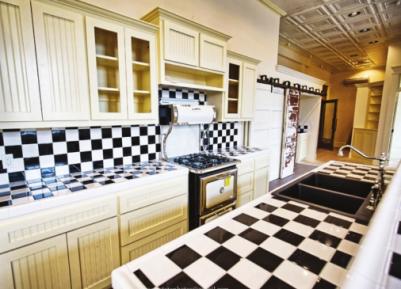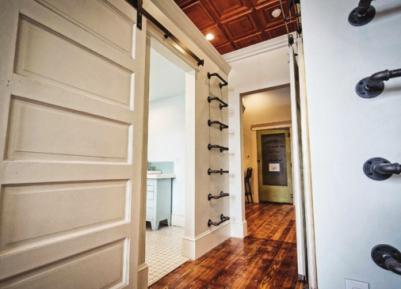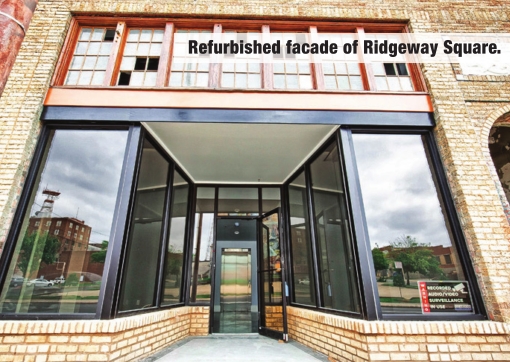Downtown Living

Home ownership expanding with Ridgeway Square
In the fall of 2016, John Cush was at the courthouse in downtown Shreveport getting ready to pay taxes on the house he had just flipped.
By the time Cush returned home, he was the owner of two commercial buildings and a parking garage.
“The parking lot had a big ‘For Sale’ sign on it,” Cush said. “About 30-45 days later, I owned them.”
But what to do with them? “I have brothers and sisters who live all over the country and all over the world,” Cush said. “In all the places I’ve visited, they are revitalizing downtown. One of the cool things is they are taking all the old buildings and basically restoring them to what they used to look like, with all the modern, cool stuff somebody would want. No one has really done that in Shreveport.”
Until now. Ridgeway Square (719 Marshall Street) is the result of Cush’s construction background and vision to offer home ownership to people who want to live downtown as opposed to renting an apartment. Phase One of the project features five condos for sale (one has already been sold).
“Right now, you can rent downtown, and a lot of people are doing it, but there’s very little available if you are not of the means to buy a whole building and if you want to own something to live in downtown,” Cush said. “For the most part, people who have rented downtown and don’t want to rent anymore but still living downtown—those are the people I’m looking for.”
Efforts to bring downtown to life have been centered around attracting people to live in “the heart of the city.” Offering properties “For Sale” as opposed to “For Rent” is another step in that direction.
“There are people who want to live downtown but will not do so unless they can purchase something,” said Liz Swaine, executive director of the Downtown Development Authority. “Conversely, we have people who only want to rent. To have a great choice in both of those areas is only good for downtown revitalization.”
The first units available at Ridgeway Square vary in size, from 550 to 2,850 square feet. Each features hardwood floors, a stand-alone tub and new appliances.
 “The
top floor, there are four condominiums upstairs done in 1920, 1930s
style,” Cush said. “Everything is brand new. All-access controlled.
You’ve got card readers, you can buzz people in and out. There’s an
elevator, a full sprinkler system, a fire alarm—everything you can think
of.”
“The
top floor, there are four condominiums upstairs done in 1920, 1930s
style,” Cush said. “Everything is brand new. All-access controlled.
You’ve got card readers, you can buzz people in and out. There’s an
elevator, a full sprinkler system, a fire alarm—everything you can think
of.”
In short, Cush has done all the work. All you have to do is live.
“Many of the buildings downtown that we have for sale that people could rehab for residential, it’s going to take a lot of time, a lot of effort, and a lot of money,” Swaine said. “There are people who are OK with doing that, and there are people who would prefer to walk into something that is turnkey.
John’s (development) is definitely turnkey. You walk in, everything is up to code, it’s beautiful, it’s brand new, but in an old building—and there is a lot of appeal to that.”
When it came to renovations, Cush received some help. Not from a person, but from the state. He took advantage of the state Commercial Tax Credit Program.
“What the tax credits allow you to do is take a commercial building that is considered a contributing feature, and rehab that building with the knowledge that someone is assisting you a little bit,” Swaine explained. “People who are developing buildings are doing it with the belief, certainly the hope, that they are going to be able to, if not make money, at least not lose money on the project. Commercial buildings—old, especially historic buildings— are tricky because you don’t know what you’re getting into. What the tax credits do are give you a little bit of certainty that if you do things the right way—if you follow the rules—there will be a return on your investment.”
“If it weren’t for that 25 percent, the numbers never would have worked,” Cush said.
Whether Cush’s plan works – offering home ownership downtown – remains to be seen.
“If downtown comes along like it has been, if it continues to grow in appeal, I might be in the catbird’s seat. You never can tell.”
To learn more about Ridgeway Square, you may visit www.ridgewaysquare.com.
– Tony Taglavore

